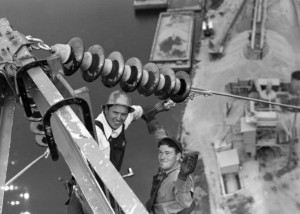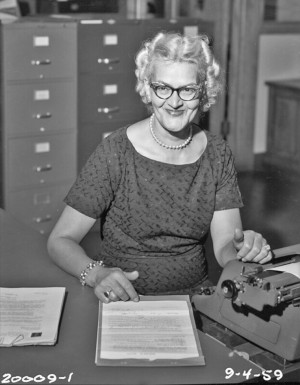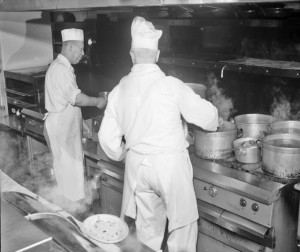

How much did people earn in the 1950s?

Image by Seattle Municipal Archives licensed under Attribution 2.0 Generic (CC BY 2.0)
How much did people earn in the 1950s in the US?
The median income of people in the US rose from $3,000 in 1950 to just under $5,000 in 1959. Professional and managerial employees could expect $7,000 to $8,000 by the end of the 1950s.
The table below shows the average annual income of employees in various occupations in the 1950s in the US.
| Occupation | 1950 | 1955 | 1959 |
|---|---|---|---|
| Agriculture | $1,349 | $1,554 | $1,683 |
| Mining | $3,448 | $4,701 | $5,540 |
| Construction | $3,330 | $4,414 | $5,254 |
| Manufacturing | $3,300 | $4,351 | $5,215 |
| Wholesale & retail | $3,084 | $3,702 | $4,301 |
| Finance, insurance and real estate | $3,217 | $3,968 | $4,714 |
| Transportation | $3,696 | $4,697 | $5,385 |
| Communication | $3,318 | $4,426 | $5,063 |
| Services | $2,220 | $2,867 | $3,420 |
| Government | $3,016 | $3,710 | $4,500 |
Source: Average annual earnings per employee, by industry 1940 to 1960, published in the Statistical abstract of the United States, 1961, page 322
Jobs in the mining and construction industries paid very well in 1950s America.
Clerical workers

Image by Seattle Municipal Archives licensed under Attribution 2.0 Generic (CC BY 2.0) (Image: public domain)
More than nine million men and women worked in clerical occupations in the United States in the 1950s.
Women starting out in clerical jobs in 1957 as filing clerks or office juniors earned up to $55 per week. Women bookkeepers could do better at $55 to $70 per week.
Secretaries could make between $60 and $90 per week.
The best-paid clerical workers were accounts clerks who could make up to $100 a week. They were usually men.
This is a selection of clerical jobs that were advertised in the press in the 1950s.
- Experienced stenographer - $50 per week (1951)
- Stenographer (Chicago) - $75 (1959)
- Clerk typist - $40 per week (1951)
- Key punch operator (Chicago) - $333 per month (1959)
- Executive secretary aged 30 to 40 (Chicago) - $400 per month (1959)
Sales occupations
About four million people worked in sales jobs in 1950s America. The bulk of those were in retail sales, ie selling directly to consumers in stores or in car dealerships.
Starting salaries were low, $25 to $50 per week depending on the location and type of business. In 1958 sales staff in hardware, bakery, drug, jewelry and clothing stores earned between $40 and $60 for a 40-hour week.
With a bit more experience and know-who they could boost those earning significantly. The top salesmen in the automotive trade could pocket $100 per week in pay and commission.
Graduates
In 1950 graduate salaries varied from $1500 to $4000. Technical graduates did better than non-technical graduates.[1]
In 1956 college majors in math or science could expect to earn between $4800 and $7200 on graduation. Arts graduates earned from $3600 to $4800.[2]
Doctors and nurses
Qualified nurses employed in public healthcare earned on average $4,301 in 1958. Doctors earned considerably more. A qualified physician could expect a salary of around $15,000 in 1955.
Catering

Image by Seattle Municipal Archives licensed under Attribution 2.0 Generic (CC BY 2.0) (Image: public domain)
In 1958 more than one million men and women were employed in the catering business in the United States.
Waiters and waitresses relied heavily on tips to supplement a basic wage. Rates per day (not including tips) varied, depending on the location. For example, waiters and waitresses were paid $6 per day in Chicago, but $10 per day in San Francisco.
Cooks of average skill could earn $50 to $100 per week in 1958. Top chefs could demand huge salaries. Some earned from $5,000 to $15,000 per year and the very best more than $25,000.
Trainee restaurant managers started at $3,600 in 1958. With experience and a college degree they could earn up to $10,000.
Armed services
In 1951 GIs stationed in Europe received pay of $990 pa. Officers got a lot more. Generals received pay of up to $13,000 pa. [3]
Teachers
In 1951 high school teachers in New York earned $5,650. [4] By 1956 they could earn up to $7,600. [5]
Teachers at Arlington County High Schools had a starting salary of $3,700. After 15 years they could earn up to $5,700.[6]
Auto mechanics

Image by Seattle Municipal Archives licensed under Attribution 2.0 Generic (CC BY 2.0) (Image: public domain)
Pay for auto mechanics was between $1 and $2 per hour in 1952. By 1958 this had risen to $2 to $3 for mechanics working for main auto dealers.
Police
In 1952 a newly-qualified policeman would earn at least $2,500. A police captain in New York earned a salary of $6,400.
By 1957 a first-grade police patrolman made $5,706. Fireman in New York City at the same grade received identical pay. Both got a uniform allowance. [5]
Pay behind bars
Prisoners
Prisoners were paid for doing basic tasks during their time in the jail. In 1955 they earned just 15c per day. They were expected to pay for soap, sugar, cigarettes and small items. One prisoner at Connecticut State Prison claimed it wasn't enough to live on. He asked for a raise to 25c [7].
Prison guards
On the other side of the bars in 1958 prison guards in New York State were paid between $4080 and $7760. Pay was equal for men and women.[8]

Los Angeles Times, CC BY 4.0, via Wikimedia Commons
What were the best paid jobs?
The highest-paid executive in 1956/7 was 81-year-old Eugene Gifford Grace, the Honory Chairman of Bethlehem Steel Corp. He received a salary of $809,000.[9]
The chairman of General Motors, Harlow Curtis, was paid $556,000.[8]
The President of the United States was paid $100,000 in the 1950s.
Baseball players in the major league were well paid. There was a minimum salary of $7,000 paid to players in 1957.[10] Top players could earn up to $75,000 pa.
The other end of the scale.
On May 2 1950, 3,000 men queued up at 533 West 59th Street, New York, to apply for 110 jobs as city cleaners paying from $1,920 to $2,040. The first in line was 32-year-old George Bacic of 593 President Street, Brooklyn. He had been unemployed for a year and had two children to feed. [11]
Minimum hourly rate
There was a minimum hourly rate approved by Congress. It was set at 75c in 1950 and increased to $1 in 1956. The rate did not apply to all workers. It covered only those engaged in interstate commerce or the production of goods for interstate commerce.
References
Unless otherwise stated, rates of pay are taken from the 'Occupational Outlook Handbook', published by the United States Department of Labor in 1959
[1] 'Half million June graduates find job openings equal to last year's' by Benjamin Fine, published in the New York Times, June 18 1950, page 1
[2] 'Education in review' by C L Sutzberger, published in the New York Times, May 27 1956, page 173
[3] 'Variations in pay of armies a poser for Atlantic nations' by Benjamin Fine, published in the New York Times, August 8 1951, page 7
[4] 'Pay rise is urged for city colleges', published in the New York Times, March 13 1951, page 33
[5] 'Teachers scorn pay plan; rise would aid only 40%', published in the New York Times, March 28, 1957, page 1
[6] 'New teacher salary scale is proposed', published in the Washington Post, February 16, 1957, page B1
[7] 'Convict asks rise in his prison pay', published in the New York Times, January 14, 1955, page 1
[8] 'Jail matrons get rise', published in the New York Times, September 27, 1958, page 26
[9] The Guinness Book of Records (1958)', page 150
[10] 'Majors boost player salaries', published in the Chicago Defender, October 1, 1957, page 24
[11] '3,000 men seeking 110 cleaners' jobs', published in the New York Times, May 3 1950 page 17
By Steven Braggs, July 2023


Comments